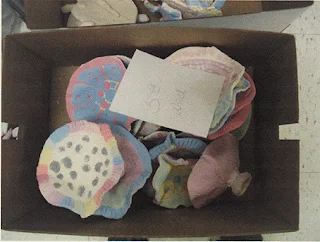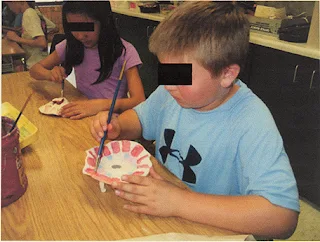 |
| Teacher's sample of a drape bowl. A shell was used to make the patterns in the clay. |
Title: Ceramic Drape Bowls
Topic: learning to work with clay, sculpture
Goals & Objectives:
- Students will model clay with control.
- Students will build upon past knowledge in order to craft an original, three-dimensional artwork.
- Through observation, investigation and discipline, students will create an art object demonstrating the use of the elements and principles of design.
- Students will use ceramic vocabulary when referring to the processes of shaping clay objects.
GLEs:
Strand I: Product/Performance for Sculpture, Ceramics, Other Media
A.2. Select and apply three-dimensional media, techniques, and processes to communicate ideas and solve challenging visual art problems.
Grade 4 - Build or layer materials to create a relief, Apply a variety of paper folding techniques, Modeling with clay or a similar material;,Make organic forms
Grade 5 - Combine simple forms to create a complex object/form (in-the-round), Use paper joining techniques such as tabs and slits, Modeling with clay or a similar material:, Build a form using a coil techniques
Strand II: Elements and Principles – Form
C. 1. Select and use elements of art for their effect in communicating ideas through artwork.
Grade 4 - Identify and demonstrate relief sculpture, Identify and use organic form
Grade 5 - Identify and use the illusion of form: cube, sphere, cylinder, and cone
A.2. Select and use principles of art for their effect in communicating ideas through artwork.
Grade 4 - Identify and use radial balance
Strand V: Historical and Cultural Contexts That Describe Characteristics of Artworks
B.1. Compare and contrast artworks from different historical time periods and/or cultures
Grade 4 - Compare and contrast two artworks on: Subject matter, Media, Use value and space, Theme, Purpose of art in culture, Place
Grade 5 - Compare and contrast two artworks on: Time, Place, Subject matter, Media, Use of elements, Theme, Purpose of art in culture, Use of materials and technology
Grade: 4th and 5th
Length of Class Period: 55 min.
Frequency of Class Period: once a week
Time Needed: three class periods
Facility & Equipment Requirements:
- One computer lap top
- Room with good lighting
- Large tables, approximately ten, each seating four students
- Two sinks
- Dry erase board
- Drying racks
- Cabinets for storage
- Projector for viewing computer video, CDs and DVDs
- Kiln for firing porcelain drape bowls
- "The Potters of San Marcos"
- The Potters of San Marcos Power Point
- Tips for beginning potters by Murry's Pottery. This video collection is appropriate for very young students. Murry shows basic techniques, child appropriate language, kind voice, secular presentations, excellent visuals and explanations. (15 videos)
- Sample for the chalkboard/interactive whiteboard
Materials Per Student:
- Both a large and small paint brush
- A selection of glazes in egg carton, one carton per four students
- A large container of water, one per four students
- A paper towel
- Amount of clay approximating the size of a tennis ball per student is used for the modeling of this object
- A variety of clay printing and modeling tools (wood chips, shells, pencils, clay stamps, etc...)
- Each student will need one burlap placemat to keep his/her working space clean and also to prevent clay from sticking to their counter space while he/she works
Vocabulary/Terminology:
- pinch - to form clay between the fingers and the palm
- coil - a rope-like formation of clay
- slab - a evenly rolled or pressed layer of clay
- bisque - is clay that has been fired but not yet glazed
- ceramics - are objects created from stoneware, porcelain or terra cotta
- clay - soil, water and sand
- fire - is the name for the heat that is used in a kiln
- glaze - a glass paint used on pottery
- kiln - a special oven used for hardening clay
- greenware - pottery that is not yet fired in a kiln
- leather hard - the hard condition of clay when it is almost air-dry
- score - roughen the clay's surface so that a bond may be formed between two surfaces
- sculpture - a three-dimensional art work
- slip - a liquid clay used to glue two pieces together
- texture - press into the clay surface with objects to create a pattern, design or rough surface
- radial design – a type of design based upon a spinning, circular pattern
Motivation- Looking and Talking Activity: Students will read in small groups and fill out a worksheet. The article is “How China Cups And Saucers Are Made.”
Step-by-Step Studio Activity Specifics:
- The teacher will begin the studio lesson with a demonstration including the following steps. Then the students will repeat the very same steps.
- Roll your clay ball in the palms of your hands, do not flatten the clay but compact it into a smooth firm ball for two minutes.
- Gently press and turn, press and turn the ball into a hamburger shape onto your burlap mat. Repeat this process until the hamburger shape is a bit larger than the palm of your hand.
- If your clay shows signs of cracking, you may add water droplets to the surface of the clay and rub them into the clay as you work.
- Slowly press in the middle of the clay shaped hamburger then turn the clay clockwise, pressing down and out to shape a pancake like slab. Do this step repetitively, and slowly until the round slab shape measures approximately five to six inches in diameter.
- Press into the clay with a variety of clay printing tools to create a radial design.
- Crush soft paper towels and place a firm wad on top of the designed surface.
- Turn the pancake shaped slab over.
- Shape the drape bowl into a “taco” like shape.
- Shape feet. This may be balls, stilts, rings, or pinch pot type
- Remember to scratch and attach surfaces using also droplets of water to create a firm bond.
- Leave the paper stuffing in place until the clay of the bowl has set. (overnight)
- The teacher will remove papers before firing.
- After the coil pot has been fired, students may glaze three coats of every color at the very least in order to properly cover ceramic pots.
- Try not to apply glaze to the bottom surface edges of footed pots if it can be helped.
- Students may later glue a circular felt round to the bottom of their ceramic pieces to avoid leaving scratches on furniture.
Special Needs Adaptations:
Modifications for the hard-of-hearing or deaf student:
- Student will be seated closer to instructor so they will be better equipped to hear instructions or read lips
- Student will be provided with written instructions so that they read about the discussions and demonstrations
- The instructor may use a amplification devise provided by the school or student’s parents
Modifications for the student with limited vision or blindness:
- Students will be allowed to observe samples of art projects with their hands and for extended periods of time
- Students will be provided with safe tools and one-on-one guidance during a demonstration of the project
- The project may be slightly adjusted to accommodate the student’s limitations or for safety reasons
- Student will be given ample time to exist classroom before large crowds gather outside of the classroom.
Modifications for students with mild brain injury:
- Students will be provided with duplicate instructions for home and school. Student will not need to remember to carry home materials to review.
- Students will be given ample time to exist classroom with a pre-determined aid or peer before the official end of a class.
- Instructor will provide for parent e-mail communication concerning the progress and needs of their student.
- Student may be given special seat assignment in order to enable his participation in class appropriately. Specific peers may be better equipped to articulate projects visually for this student.
Health & Safety Concerns: There are no health and safety concerns for this project.
Cleanup Time & Strategy: Students will be instructed to put away art materials neatly in their containers, clean off their tables, and recycle their trash two minutes prior to dismissal.
 |
| Side view of teacher sample drape bowl |
 | |||
| Bottom view of teacher sample drape bowl |
 |
| Student printing radial design into clay |
 |
| Student working on top of burlap to keep tables clean and keep clay managable |
 |
| Drape bowls have been glazed and are ready for a second firing |
 |
| Drape bowl after second firing |
 |
| Student glazing his drape bowl after first firing |
 |
| Drape bowl feet come in all shapes and sizes |
 |
| A side view of teacher's sample drape bowl |
 |
| Radial design on top of a drape bowl. |
all articles and lesson plans are copyrighted 2011 by Grimm


1 comment:
this is great, thanks!
Post a Comment